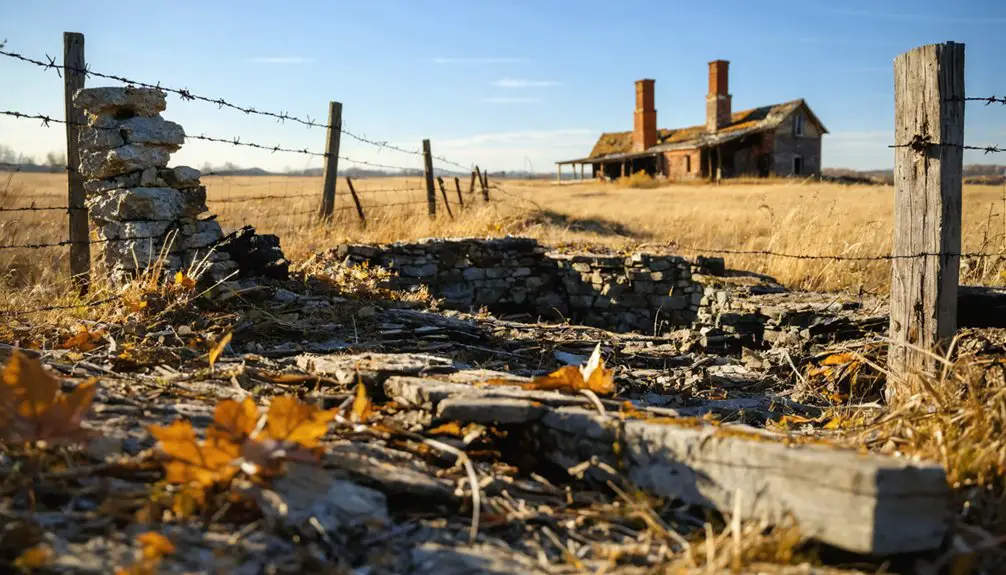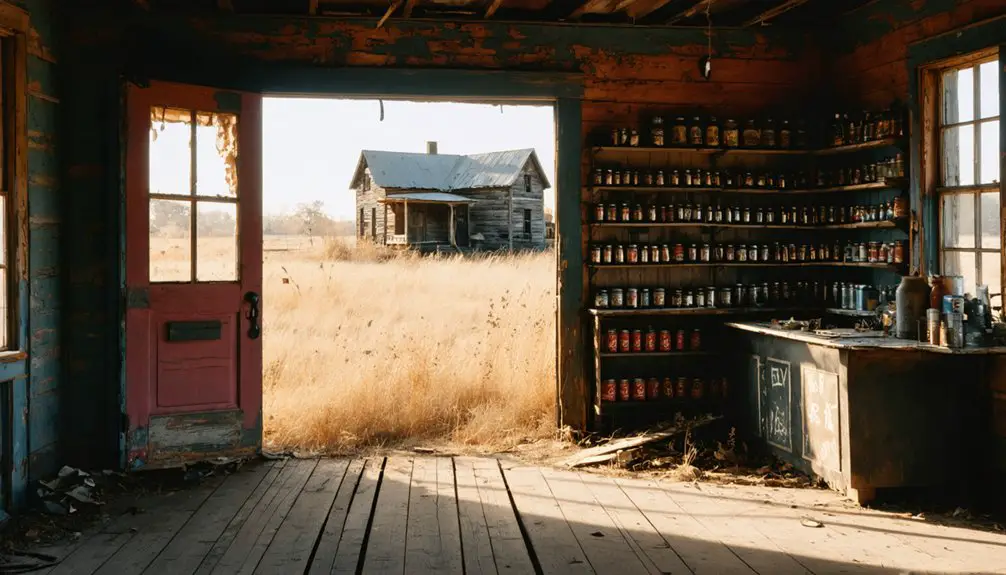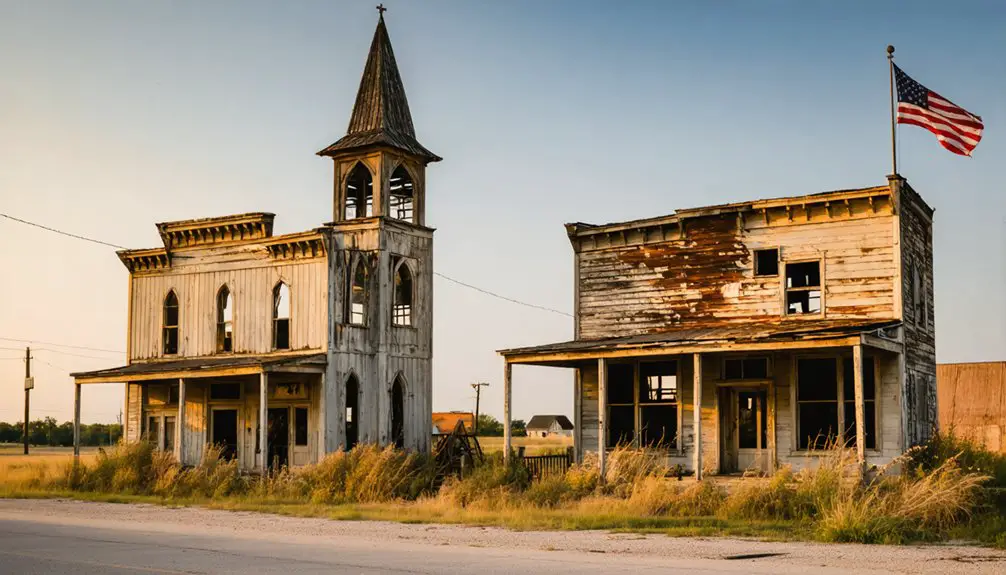You’ll find Sumpter, Oklahoma about 5 miles north of Blackwell in Kay County, where it emerged in 1862 after five Confederate veterans discovered gold near Cracker Creek. The settlement grew slowly, establishing its first post office in 1874, and later experienced changes during Oklahoma’s 1897 oil boom. Today, you can explore remnants of early 20th-century structures, including the well-preserved former hospital that now operates as a bed and breakfast, while uncovering layers of frontier history.
Key Takeaways
- Sumpter was established in the 1860s near Cracker Creek, with its economy initially driven by gold mining activities.
- Located in Kay County, Oklahoma, approximately 5 miles north of Blackwell, with coordinates 36° 53′ 1″ N, 97° 17′ 39″ W.
- The town reached its peak population of 300 residents after the late 1890s development of mining and oil industries.
- Notable remains include the former hospital (now a bed and breakfast) and various crumbling early 20th-century structures.
- Visitors should explore during daylight hours, wear protective footwear, and avoid disturbing historical structures or removing artifacts.
The Rise and Fall of a Forgotten Settlement
While the California Gold Rush drew most prospectors westward in the 1860s, the discovery of gold near Cracker Creek led some fortune seekers to establish what would become Sumpter, Oklahoma.
You’ll find Sumpter’s economy initially struggled due to its remote location, with only a primitive cabin and scattered mining operations marking its humble beginnings. It wasn’t until 1874 that the town received its first post office, signaling gradual development. Like many of Oklahoma’s two thousand ghost towns, Sumpter’s fate was sealed by resource depletion and natural disaster.
The real transformation came in the mid-1890s when advances in mining technology revolutionized gold extraction. By 1900, the booming town had generated nine million dollars in gold from its numerous mines.
The arrival of the Sumpter Valley Railway in 1897 connected the town to crucial trade networks, boosting the population to 300 residents. New businesses emerged, and Sumpter briefly flourished as a local hub before a devastating 1917 fire and depleted gold reserves led to its eventual abandonment.
Location and Geographic Significance
The ghost town of Sumpter sits nestled in Kay County’s prairie landscape at 36° 53′ 1″ North latitude and 97° 17′ 39″ West longitude.
You’ll find it about 5 miles north of Blackwell, Oklahoma, where the geographic features reflect the classic Great Plains environment of rolling prairies and farmland.
Rural connectivity to Sumpter remains limited, with access primarily through two-wheel drive roads that can become challenging during adverse weather.
The area’s historical gold mining operations left significant marks on the local landscape.
While snow is rare, the region’s hot summers and seasonal conditions can affect travel.
You won’t find major highways or waterways nearby, highlighting its isolation from modern infrastructure. The Blackwell Airport lies just 9.3 kilometers away, offering the closest transportation hub to the area.
The town’s location, near the Kansas border, represents a common pattern of rural settlements that lost population when bypassed by major transportation routes, serving as a reflection of Oklahoma’s shifting economic landscape.
Early Settlement Years and Native Heritage
Prior to European-American settlement, indigenous peoples including the Osage and Cherokee tribes called this region home, maintaining rich cultural traditions through hunting, farming, and trade networks. Their presence shaped the landscape until the Indian Removal Act of 1830 forced massive displacement along the Trail of Tears.
The town experienced prosperity after five ex-Confederate soldiers established the settlement while searching for gold in 1862.
You’ll find that Sumpter’s formal settlement began in the late 19th century, following broader Oklahoma settlement patterns. Early settlers established homesteads focused on farming and ranching, while Native trade relationships continued to influence local dynamics. The area became a thriving community during the gold rush era.
The town’s name likely stems from Civil War references, possibly linked to Fort Sumter. As the community grew, basic infrastructure emerged including schools, churches, and trading posts.
Water access remained essential yet limited, directing where people could successfully establish themselves in this transforming frontier landscape.
The Oil Boom Era Impact
Life in Sumpter changed dramatically after Oklahoma’s 1897 oil discovery near Bartlesville at the Nellie Johnstone well. You’d have witnessed a surge of wildcatters and workers flooding into the region, all hoping to strike it rich in the expanding oil fields.
As Oklahoma’s oil production skyrocketed through discoveries like Glenn Pool in 1905 and the Cushing field in 1912, Sumpter experienced the ripple effects of this economic growth. By 1907, the state had become the nation’s top producer of oil, fueling further development in towns like Sumpter. The economic impact was staggering, as Oklahoma’s oil production reached 906 billion barrels worth approximately $5.28 billion between 1900-1935.
The town’s landscape transformed as infrastructure expanded to support the booming industry. You’d have seen new railroads, pipelines, and support services emerging to handle increasing production demands.
However, like many boomtowns of the era, Sumpter faced environmental challenges from oil spills and poorly sealed wells, while its rapid growth strained local resources and infrastructure.
Notable Buildings and Remaining Structures
Weathered foundations and skeletal structures dot Sumpter’s landscape today, offering glimpses into its bustling past.
You’ll find abandoned architecture scattered throughout, with mining remnants and altered earth shaping the town’s layout. The former hospital, now a bed and breakfast, stands as the most well-preserved structure among the ruins. The Sumpter Valley Dredge, a massive gold-mining machine, stands as a centerpiece of the town’s industrial heritage. Extensive lead contamination from decades of mining has rendered much of the area unsafe for habitation.
- Crumbling early 20th-century homes reflect the town’s boomtown architecture
- Mining infrastructure ruins, including deteriorated headframes and shafts
- A few occupied residences persist among the abandoned buildings
- Community structures like churches and schools remain as partial ruins
- Mining tailings and debris fields surround most standing structures
The town’s buildings continue to deteriorate, with many missing roofs and walls exposed to the elements.
While some structures serve as private dwellings, most remain as silent testimonials to Sumpter’s mining heritage.
Local Stories and Cultural Legacy
Throughout Sumpter’s evolution from a gold rush boomtown to a preserved historical site, rich oral traditions and cultural practices have kept the town’s legacy alive. Local folklore highlights tales of ambitious prospectors who abandoned their California dreams after striking gold in the area.
You’ll find mining legends woven into the fabric of annual events, where residents don period costumes and demonstrate traditional gold panning techniques.
The town’s cultural heritage thrives through the restored Sumpter Valley Railroad, offering you authentic rides that showcase the crucial role of rail transport in the region’s growth.
Through heritage tourism and community gatherings, you can experience storytelling sessions that bring to life the excitement of the mining era, while historical reenactments transport you back to the days of primitive cabins and bustling mining camps.
Historical Maps and Documents

If you study early surveyor records from Kay County, you’ll find detailed plot maps marking Sumpter’s original boundaries and homesteads from the early 1900s.
Railroad route tracings from 1916 show how Sumpter connected to the broader transportation network, with specific notations about depot locations and track configurations.
These maps, along with land office documents, reveal how Sumpter’s development was closely tied to regional railway expansion and eventual decline.
Early Surveyor Records
During the mid-1800s, U.S. government survey teams meticulously documented the land that would become Sumpter, Oklahoma, creating foundational records that shaped the region’s development.
Using early mapping techniques like Gunter’s chains and transit theodolites, surveyors faced numerous challenges while establishing the township and range grid system.
- Field notes captured essential details about creeks, hills, and sparse timber
- Surveyors used triangulation methods to guarantee precise position measurements
- Teams documented magnetic declination to maintain accurate compass readings
- Official records established baseline and meridian reference points
- Survey completion certificates validated compliance with PLSS standards
You’ll find these historical records preserved in the National Archives, revealing the systematic approach surveyors took to catalog the land for settlement and resource development, while battling weather conditions and challenging terrain throughout their expeditions.
Railroad Route Tracings
Limited historical railroad documentation exists for the Sumpter, Oklahoma region, with most references erroneously pointing to the Sumpter Valley Railway in Oregon instead.
You’ll find that major archival collections, including the National Archives’ extensive railroad maps and right-of-way documents, don’t specifically mention rail routes through this ghost town.
While Oklahoma state archives contain numerous railroad maps from the early 20th century, you won’t discover direct evidence of rail service to Sumpter in public timetables or freight brochures.
To trace potential railroad history through this area, you’d need to cross-reference USGS topographic maps, land records, and railroad valuation maps.
However, these sources currently don’t confirm any rail lines serving Sumpter, making it challenging to establish the town’s connection to Oklahoma’s railroad network.
Visiting Guidelines and Safety Measures
Before visiting Sumpter’s ghost town, you’ll need to follow specific guidelines and safety protocols to guarantee a secure exploration of this historical site.
Plan your arrival during daylight hours and verify road conditions before traveling, as access can change seasonally. When practicing ghost town photography, stick to marked paths and respect preservation laws.
- Wear protective footwear for uneven terrain and watch for mining-related hazards
- Pack essential supplies including water, first aid kit, and emergency communication devices
- Follow visitor etiquette by never removing artifacts or disturbing historical structures
- Use GPS and offline maps due to limited cell service
- Consider joining guided tours for safer, more informative experiences
Remember to inform someone of your travel plans and expected return time, and always carry appropriate weather gear for Oklahoma’s variable conditions.
Preserving Oklahoma’s Ghost Town Heritage

As Oklahoma’s rich historical legacy faces ongoing preservation challenges, dedicated researchers and organizations work tirelessly to document and protect the state’s estimated 2,000 ghost towns.
You’ll find thorough preservation efforts through initiatives like Ghost Towns In Oklahoma, which actively photographs and documents these vanishing sites.
The University of Oklahoma’s extensive research has produced detailed histories from over 1,200 sources, while their Western History Collection maintains essential primary documents.
Through ghost town preservation efforts, you can now access field guides, books, and digital archives that capture these communities’ stories.
Modern community engagement strategies include social media outreach, oral history collection, and educational programs that connect you with regional heritage.
These initiatives guarantee that even as physical structures decay, the cultural significance and historical lessons of Oklahoma’s ghost towns endure.
Frequently Asked Questions
Were Any Famous Outlaws or Lawmen Associated With Sumpter During Its Existence?
You won’t find any documented outlaw legends or lawman stories connected to this location. Historical records don’t mention any famous law enforcement figures or notorious criminals operating in the area.
What Was the Peak Population of Sumpter Before It Became Abandoned?
You’ll find that during your ghost town exploration of Sumpter history, the peak population reached 2,200 residents in 1900, before dramatically declining to just 495 by 1910 and eventually dwindling further.
Did Any Major Natural Disasters Contribute to Sumpter’s Eventual Decline?
A monstrous fire, one of history’s most devastating natural calamities, struck in 1917, destroying nearly 100 buildings and sealing your town’s fate. This historical impact accelerated Sumpter’s march toward abandonment.
What Native American Tribes Originally Inhabited the Area Before Sumpter’s Establishment?
You’ll find the Spiro Mound Builders first inhabited the area, followed by Wichita and Caddoan peoples. Later, Cherokee heritage and Creek influence emerged when the Five Civilized Tribes arrived through forced relocation.
Were There Any Operating Mines Besides Oil Wells in Sumpter?
While you might expect coal mining or silver extraction given Oklahoma’s rich mining history, there’s no documented evidence of any mines besides oil wells operating in Sumpter’s territory during its existence.
References
- https://www.onlyinyourstate.com/experiences/oregon/ghost-town-eastern-or
- https://www.legendsofamerica.com/or-sumpter/
- https://bakercityherald.com/2025/07/25/column-the-oregonian-slights-sumpter-with-its-most-famous-ghost-town-claim/
- https://www.youtube.com/watch?v=-jYN1_E2VV0
- https://kids.kiddle.co/List_of_ghost_towns_in_Oklahoma
- https://en.wikipedia.org/wiki/List_of_ghost_towns_in_Oklahoma
- https://www.youtube.com/watch?v=5d-wHDTIbb0
- https://www.okhistory.org/publications/enc/entry?entry=GH002
- http://www.maplandia.com/united-states/oklahoma/kay-county/sumpter/
- http://ghosttowns.com/states/ok/sumpter.html



